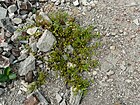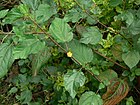Note: This is a project under development. The articles on this wiki are just being initiated and broadly incomplete. You can Help creating new pages.
Corchorus aestuans
Corchorus aestuans is an annual plant with erect, sparingly branched stems, it grows about 40cm tall. The plant yields a fibre and edible leaves. It is harvested from the wild for local use and is sometimes also cultivated as a fibre plant in tropical W Africa, sometimes also in SE Asia.
Uses
[[:Category:Ayurvedic Herbs known to be helpful to treat |]], [[:Category:Ayurvedic Herbs known to be helpful to treat |]], [[:Category:Ayurvedic Herbs known to be helpful to treat |]], [[:Category:Ayurvedic Herbs known to be helpful to treat |]], [[:Category:Ayurvedic Herbs known to be helpful to treat |]], [[:Category:Ayurvedic Herbs known to be helpful to treat |]], [[:Category:Ayurvedic Herbs known to be helpful to treat |]], [[:Category:Ayurvedic Herbs known to be helpful to treat |]], [[:Category:Ayurvedic Herbs known to be helpful to treat |]], [[:Category:Ayurvedic Herbs known to be helpful to treat |]], [[:Category:Ayurvedic Herbs known to be helpful to treat |]].[1]
Parts Used
Chemical Composition
Common names
| Language | Common name |
|---|---|
| Kannada | |
| Hindi | |
| Malayalam | |
| Tamil | |
| Telugu | |
| Marathi | |
| Gujarathi | |
| Punjabi | |
| Kashmiri | |
| Sanskrit | |
| English |
Properties
Reference: Dravya - Substance, Rasa - Taste, Guna - Qualities, Veerya - Potency, Vipaka - Post-digesion effect, Karma - Pharmacological activity, Prabhava - Therepeutics.
Dravya
Rasa
Guna
Veerya
Vipaka
Karma
Prabhava
Habit
[[:Category:Habit - |]]
Identification
Leaf
| Kind | Shape | Feature |
|---|---|---|
| Ovate | 1.3-7.6cm | Accute serrate |
Flower
| Type | Size | Color and composition | Stamen | More information |
|---|---|---|---|---|
| Yellow | 1-3 in clusters, Very shortly stalked, Very small | {{{5}}} |
Fruit
| Type | Size | Mass | Appearance | Seeds | More information |
|---|---|---|---|---|---|
| Capsule | Hexagonal | Cylindric |
Other features
List of Ayurvedic medicine in which the herb is used
Where to get the saplings
Mode of Propagation
How to plant/cultivate
Originally native to the Americas, the plant has spread throughout the tropics and has become an invasive weed in some areas.[4]
Commonly seen growing in areas
Photo Gallery
References
- ↑ Indian Medicinal Plants by C.P.Khare
- ↑ [Chemistry]
- ↑ Kappatagudda - A Repertoire of Medicianal Plants of Gadag by Yashpal Kshirasagar and Sonal Vrishni, Page No. 141
- ↑ Cultivation
External Links
- Ayurvedic Herbs known to be helpful to treat
- Herbs with Leaves used in medicine
- Habit -
- Index of Plants which can be propagated by Seeds
- Herbs that are commonly seen in the region of Grassy savannah
- Herbs that are commonly seen in the region of Fallow land
- Herbs that are commonly seen in the region of Sandy riverbeds
- Herbs that are commonly seen in the region of Small alluvial depressions
- Herbs that are commonly seen in the region of On heavy alluvial soils
- Herbs
- Pages without herbs images




